OFF-TOPIC (40)
By:
June 15, 2022
Off-Topic brings you over-the-transom, on-tangent essays, dialogues and subjective scholarship on an occasional, impulsive basis. In time for summer action-season, we exchange some banter on the journey of two broadcasters attempting a crossover from the world of nonprofit public media to the multiversal platforms of blockbuster comicbook brand-building…
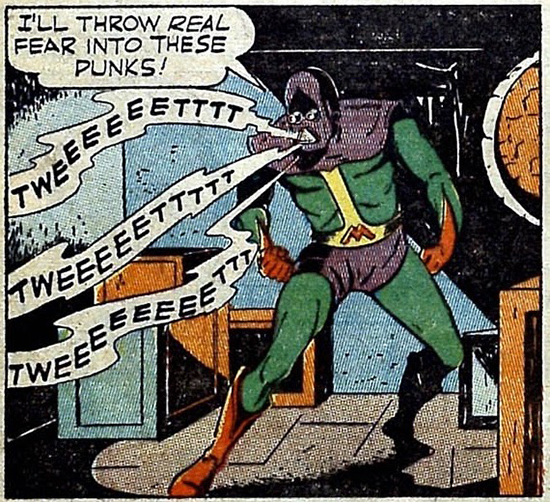
Most people working in the comics industry could have given you a whole different meaning for “microfinance,” long before the term came into common use. But for the team at NPR’s Planet Money podcast, rolling the dice as first-time comics publishers, the wonder outweighed the sometimes meager reward. Boom or bust, a point would be proven, as hosts Kenny Malone and Robert Smith set out to chronicle the mechanics of intellectual property development, merchandizing, and valuation, by taking a public-domain property from forgotten 1940s comics and seeing how he’d survive in the Marvel Studios era of marketing. It wouldn’t be the first time a superhero epic started with an unassuming test subject chosen by fate, and the team settled on the character with the dramatically inauspicious but economically apt name of Micro-Face. Reborn in the age of micropayments, microchips, microfibers and microloans, this hero relies on the pioneering WWII-era technology of… microphones, in his facemask, which allow him to amplify his voice, confuse criminals by projecting it elsewhere, and even tap into the classic interweb of telephone lines.
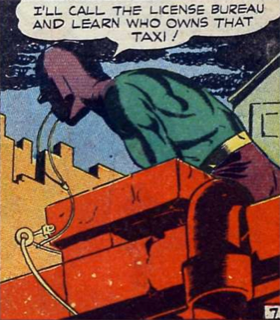
Malone and Smith acquired Micro-Face in a kind of IP foreclosure, combing the (remarkably copious) online annals of characters whose publishers went out of business and nobody bothered to renew copyright on. (The industry titans, by contrast, keep watch over every copyright, which is how Marvel can have a smash-hit reboot of Ziggy Pig & Silly Seal in 2019). Then they entered the bumpy, hero’s-journey phase of the enterprise, as the rookie effort met with veteran complications at several turns (finding printers, lining up art talent, ballooning the page-count so the art talent had to jump to a different gig and they had to completely start over, etc.).
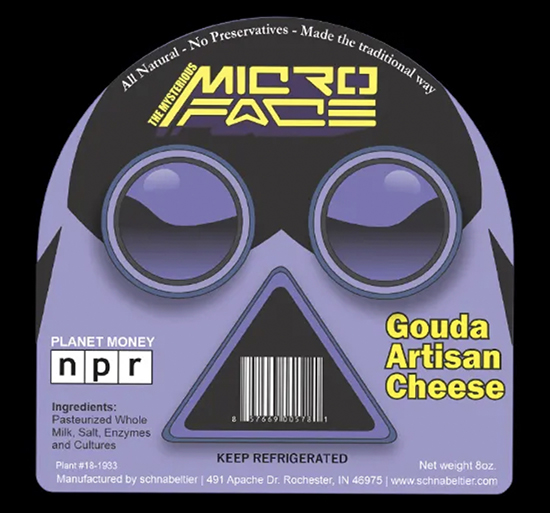
Luckily for their podcast-series content and patient followers, this itself makes a great story, as the duo learn how they can make tweaks that give them ownership of their version of Micro-Face, discover that a beverage company has beat them to the punch by bringing out a soda emblazoned with public-domain Micro-Face’s likeness, and forge ahead with their own license deals, which range from a choral work to a Broadway-style musical to a Micro-Face-branded cheese. Later (and in the spirit of HiLobrow’s own Josh Glenn and Rob Walker’s Significant Objects project), they experiment with how capitalist society subjectively ascribes value, by creating a one-of-a-kind deluxe edition of the comic to auction on eBay.
So there was a comic? Yes, The Mysterious Micro-Face premiered from Planet Money Comics in late April, and was worth both the year-long wait loyal listeners had maintained, and the lifetime one that others like me didn’t even know we’d been having.
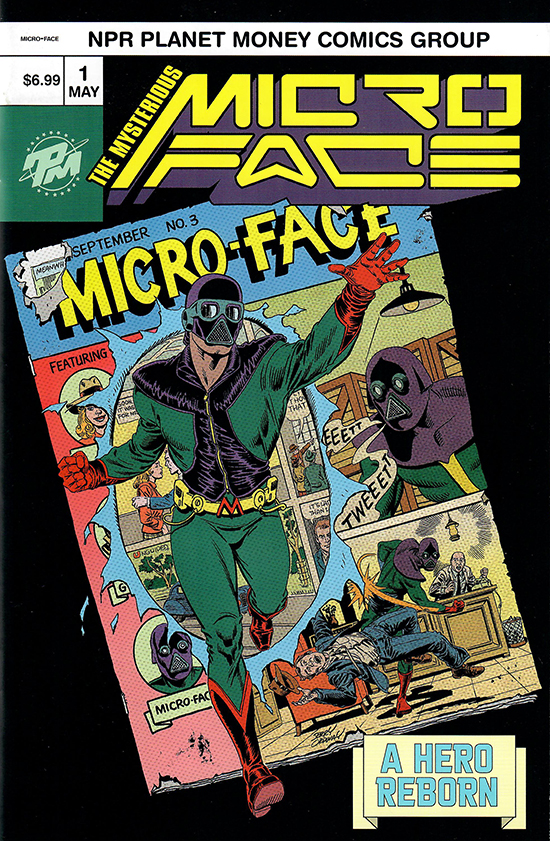
Redesigned by Jerry Ordway, drawn and brought to life by Jamal Igle, and scripted by longtime Archie Comics writer Alex Segura, from the original created by Allen Ulmer (and with his daughter Peggy Loucks’ participation and blessing), The Mysterious Micro-Face radiates affection for the comics medium and exudes the freshness of its earliest days. One in a burgeoning parallel marketplace of comics commissioned by corporations, issued by universities and museums, or funded by foundations, and one-of-a-kind as a sort of financial thriller, the story follows original Micro-Face alter-ego Tom Wood’s grandson, NPR reporter (what else?) Sam Salazar. Sam receives the costume and a confession from his long-gone grandpa by mysterious mailing, after a nefarious private equity firm starts buying up the assets of Tom’s old company and others — all of whom secretly held retired-superhero gear, which could be sold to make two kinds of killings on the underground market. Sam follows the strange vulture-capitalist trail, while his colleague, BFF and recently-ex-GF, Amina, has been following a story on those same forgotten superheroes. Their tracks converge in a confrontation with a cabal of evil geniuses in corporate clothing, and in Sam donning the mantle of his grandfather to foil this illicit arms-traffic both on the air and in the shadows.
Segura shows an unerring sense of conversational comedy and ear for natural speech in bizarre situations, and brings equal expertise to scenarios of corporate satire, family sentiment and heroic citizenship; Igle choreographs action scenes and everyday dialogues with a shared dynamic repertoire of dramatic angles, kinetic 2-D camera-work and charged expressiveness; a master meld of pop-art charm and contemporary sharpness. The experiment may have concluded but I want the adventure to be continued! In any case, while hoping that Micro-Face Will Return, I was able to track Segura to his headquarters and get the story behind the story-thus-far…
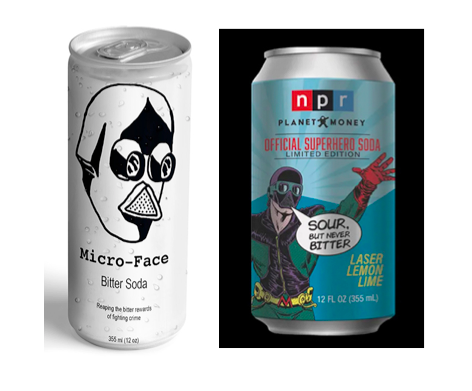
HILOBROW: Fans fret that comics these days are mostly kept in print as, like, the brochure for companies marketing the IP in other media. In that context it’s funny (though I know unplanned) that the (superb) Micro-Face comic was the last thing to come out after all the tee-shirts and designer cheese. That could be interpreted two ways: As a satire of content-less brand allegiance; or as a serious statement on the desirability of transmedia experiences & fan cohorts over any one mere medium or artwork. Does either apply, in your view?
SEGURA: No, it doesn’t! Ha. It’s just pure timing. I think when we started this whole adventure, Kenny and Robert thought the comic would come together fast — and that’s just not how comics work. As they outlined in the most recent Planet Money episode about Micro-Face, they added a ton of pages during the scripting process — which created a ripple effect in terms of the schedule. We’re all amazingly proud of the end result, but comics have never been fast or easy to produce, even more so if it’s your first one. So, no, there was no underlying strategy to the order in which the MF products were released.
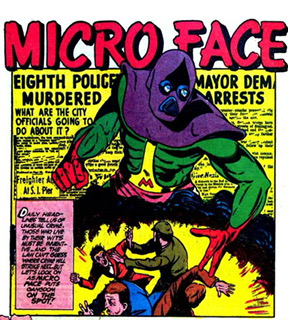
HILOBROW: Maybe it’s the underdog aspect of always fighting to break the surface of pop culture, but public-domain action heroes feel more plausible somehow — and one way this plays out is that they usually exist in more realistic timelines than the perpetual “Big Two” properties. They get old; they’re just memories from another era; if they do come back to the world some explanation is necessary. Your Micro-Face book takes this real-time, legacy-hero approach. Is there a built-in “where have they been” factor for characters as obscure as these? Or, is it natural for these characters to be more like real people cuz they’re publicly-shared?
SEGURA: I never thought of it that way, to be honest. When Kenny, Robert, and I were talking about how to approach rebooting Micro-Face, I told them we had three paths: the complete, ground zero relaunch, where nothing existed before. The period piece, where we continue the adventures of Tom Wood, the original Micro-Face, in the 1940s. And, finally, the legacy hero — where everything in those original MF comics happened, but we were now following the next person to carry the mantle. The last one appealed to me most, because it cemented the version that NPR owns and it doesn’t negate anything that’s come before. I’m also a sucker for legacy heroes, like the JSA and so on. So it felt like the most creative approach.
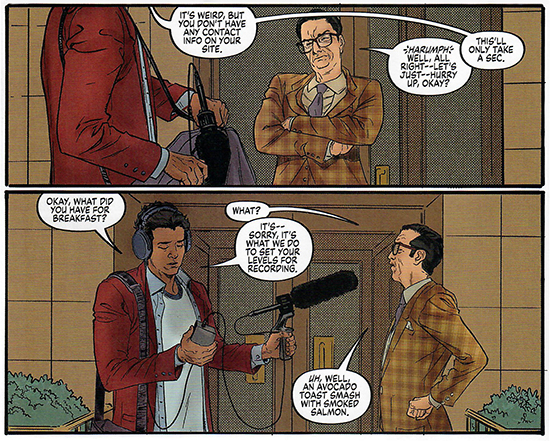
HILOBROW: It’s funny that this comic gets across a lot of financial ideas while being first and foremost an entertaining read, because comics history is full of tie-ins where the message came first — from selling tootsie rolls to warning against plaque — and the heroes were just the vehicle. Was it important to everyone for the comic to stand on its own, and at the same time do you think this could be the model for advertainment done right?
SEGURA: I’d never presume something I worked on would be a model for anything. I approached Micro-Face the same way I approach any story — with the desire to entertain. First, to entertain myself and get jazzed about the assignment, then to entertain my editors (Kenny, Robert, and Ivan [Cohen]), then to engage with the artist, Jamal, who I have a huge amount of respect for and have considered a friend for almost 20 years. The “advertorial” aspects of the comic were important, of course — we wanted to make a fun comic for business readers and fans of the podcast, but it had to be woven into an entertaining superhero story, not vice-versa. Otherwise, you’d be reading an infographic, not a story. So, yes, it was hugely important that The Mysterious Micro-Face #1 stood on its own, as an entertaining comic book, period, with the rest as gravy.
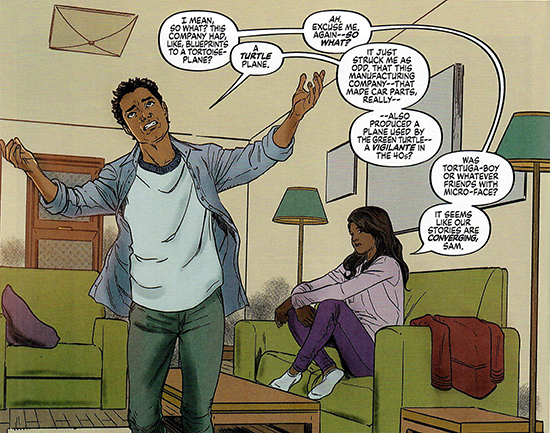
HILOBROW: What makes this comic a true successor to its golden-age sources is the inherent fun, and also unabashed integrity. Sam Salazar knows his costume and codename are silly but also knows his adventures are awesome; at the same time, journalists are targets these days, but Sam and Amina disregard danger to serve society. Whimsy and earnestness weren’t mutually exclusive in older comics; was that one attraction to working on this?
SEGURA: I think, in general, that we have to embrace the absurdism of superhero comics sometimes — [though] not in a way that pokes fun or lessens the genre. I love the tropes of superhero comics. I love the colors, the grandiose statements, the maniacal villains. Like any genre, there are tropes and things that are ever-present, but your challenge as a creator is to honor the tropes you like, invert the ones that give you grief, and ignore the ones that are outdated or just plain wrong. When I was crafting the story, with input from Kenny and Robert, I wanted to make sure this felt like a real comic; not someone’s idea of a comic. Not someone riffing on superhero cliches and making fun of the genre. I treated the content seriously, through the prism of superhero comics. So that’s where that comes from — we played it straight.
HILOBROW: It’s unusual to see dialogue that’s so witty yet so naturalistic, and plotting that’s so razor-sharp but relaxed in its down-to-earth events. I feel like we’re coming in on a few days of these characters’ real lives instead of just a handful of scenes staged to construct the story. Does writing humor and non-super characters prepare you specially for this kind of believable, relatable adventure?
SEGURA: I think so. Humor is the hardest kind of story to write — and I learned that firsthand, working at Archie for years. It’s not just about the final gag; it’s about setting up the gag, choreographing the gag, then nailing the gag. Not easy. As for non-super characters…I think there’s some truth to it. You want your characters to feel real, like people you could run into in the street. Not archetypes, not parodies, and certainly not two-dimensional. With any story, I start with character — who is Sam Salazar? What’s his conflict? Who is Amina? What’s their conflict with each other? What does Golden Age Private Equity want? What’s the twist? What’s the red herring? Once you nail those things down, you can set the characters down and see where they move, within the constraints of the plot.
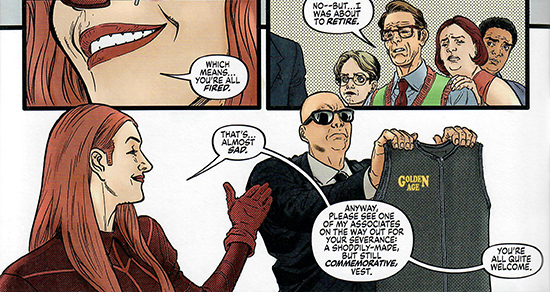
We knew we wanted to get a ton of Easter Eggs in the book, for example. So how do we do that in a way that feels organic and not staged for the purposes of this NPR comic? These are all the things I kind of pulled and pushed on while writing the story. Working with someone like Jamal makes it really easy, though, because he does the heavy lifting — not just in terms of time and effort, but in terms of story. I don’t have to explain that Sam is mad, for example; Jamal shows it with an expression. So that frees me up to focus on the dialogue and making sure it’s sharp and memorable. Kenny and Robert and the entire Planet Money team were also huge resources in terms of making sure we got the biz lingo right, and for allowing us to poke fun at it, too. I mean, our villain is called Corporal Raider!
HILOBROW: It occurs to me that family-business sagas may be America’s closest answer to elite costume drama — I was on the edge of my seat for Rich Cohen’s history/memoir Sweet and Low, and Micro-Face has that same kitchen-sink epic feel. Is this comic built on a classic model from a lot further back than comics?
SEGURA: I mean, maybe! I think the idea of legacy [is] a flexible one — and it is at the heart of a lot of great fiction, whether it’s a crime saga like The Godfather or a comic like Micro-Face. So many stories are about trying to live up to expectations or what our parents/mentors/heroes asked of us.
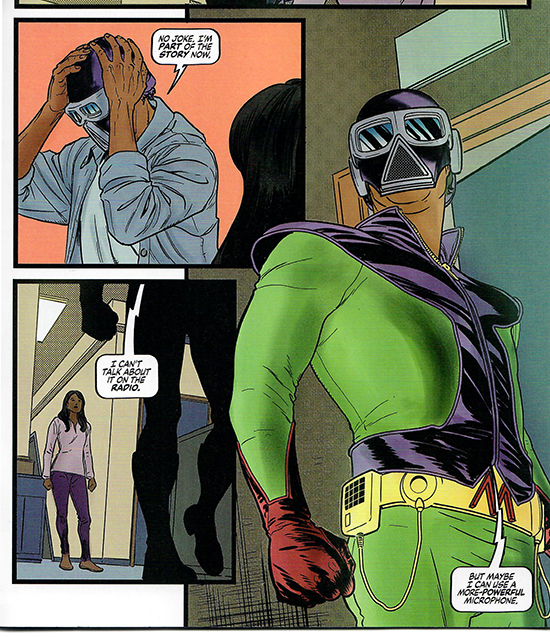
HILOBROW: Any other points we didn’t cover about vintage comics, financial literacy, journalistic standards, art as commodity, etc.?
SEGURA: The big thing I want to say is this was an absolute blast and honor to work on. I’m so indebted to Kenny and Robert for bringing me along for this ride, and to our amazing creative team. Never in my life did I think I’d be able to co-create a character with legends like Jerry Ordway and Jamal Igle. This project will forever hold a special place in my heart, and I’m so thankful people seem to be enjoying it.
Artist Jamal Igle comments on his current classic imagery for Micro-Face: “My approach has always been to push clarity, to always keep in mind that every comic may be someone’s first comic book. It’s something that I’ve always expressed to my students. The other part is my belief in ‘verisimilitude,’ a term the late Richard Donner applied to the filming of Superman: The Movie in 1978, the idea that you have to present a fully realized world for your readers. That takes planning and patience, but I think it’s worth it.”
Images (from top to bottom): An olde Allen Ulmer panel teaches us who invented the Tweet; Ulmer’s hero jacks in; Micro-Face aged to perfection; 2022 cover by Jerry Ordway; Infinity (Soda) War; Micro-Face Year One, Page One (Ulmer); four gripping film-clips on paper from Igle’s first issue (colors: Ellie Wright; letters: Taylor Esposito)
MORE POSTS by ADAM McGOVERN: OFF-TOPIC (2019–2025 monthly) | textshow (2018 quarterly) | PANEL ZERO (comics-related Q&As, 2018 monthly) | THIS: (2016–2017 weekly) | PEOPLE YOU MEET IN HELL, a 5-part series about characters in McGovern’s and Paolo Leandri’s comic Nightworld | Two IDORU JONES comics by McGovern and Paolo Leandri | BOWIEOLOGY: Celebrating 50 years of Bowie | ODD ABSURDUM: How Felix invented the 21st century self | KOJAK YOUR ENTHUSIASM: FAWLTY TOWERS | KICK YOUR ENTHUSIASM: JACKIE McGEE | NERD YOUR ENTHUSIASM: JOAN SEMMEL | SWERVE YOUR ENTHUSIASM: INTRO and THE LEON SUITES | FIVE-O YOUR ENTHUSIASM: JULIA | FERB YOUR ENTHUSIASM: KIMBA THE WHITE LION | CARBONA YOUR ENTHUSIASM: WASHINGTON BULLETS | KLAATU YOU: SILENT RUNNING | CONVOY YOUR ENTHUSIASM: QUINTET | TUBE YOUR ENTHUSIASM: HIGHWAY PATROL | #SQUADGOALS: KAMANDI’S FAMILY | QUIRK YOUR ENTHUSIASM: LUCKY NUMBER | CROM YOUR ENTHUSIASM: JIREL OF JOIRY | KERN YOUR ENTHUSIASM: Data 70 | HERC YOUR ENTHUSIASM: “Freedom” | KIRK YOUR ENTHUSIASM: Captain Camelot | KIRB YOUR ENTHUSIASM: Full Fathom Five | A 5-part series on Jack Kirby’s Fourth World mythos | Reviews of Annie Nocenti’s comics Katana, Catwoman, Klarion, and Green Arrow | The curated series FANCHILD | To see all of Adam’s posts, including HiLo Hero items on Lilli Carré, Judy Garland, Wally Wood, and others: CLICK HERE
